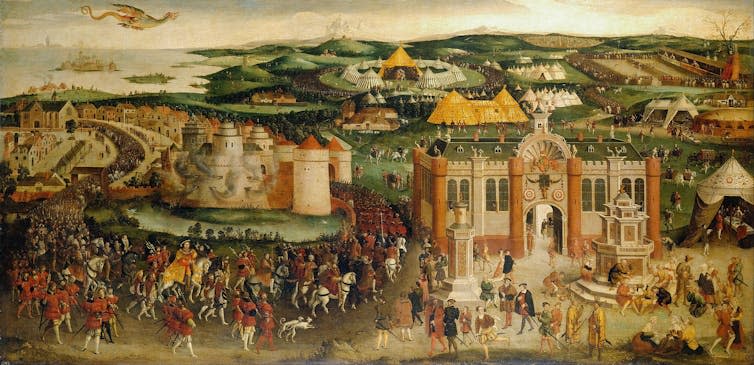How Henry VIII’s grandmother used a palace in Northamptonshire to build the mighty Tudor dynasty
Today, you would be hard-pressed to find any visible evidence that Collyweston village in Northamptonshire was once home to a palace presided over by Henry VIII’s grandmother, Lady Margaret Beaufort. As a royal power base, the palace was an epicentre of Tudor power and propaganda in the 16th century and was a key stopping point for royal visits. This included two royal tours in 1503 and 1541, which were crucial to the making (and remaking) of the Tudor dynasty.
Margaret Beaufort acquired Collyweston manor after her son Henry VII ascended to the English throne following the battle of Bosworth in 1485. There, she set upon expanding the manor house into a palace befitting her status as king’s mother.
Beaufort’s presence at Collyweston formed part of a strategic plan, devised by mother and son, to exert royal influence both locally and nationally. Collyweston was in the heart of the country at a time when most of the royal palaces were clustered in and around London and the neighbouring county of Lincolnshire was the epicentre of Beaufort’s influence.
In the early years of the Tudor dynasty, Beaufort’s presence in the area was particularly important as Henry VII had spent much of his youth in exile in Brittany. His mother’s longstanding connections to the local area therefore helped proclaim his legitimacy.
The site was also close to the Great North Road (now partly occupied by the A1), making it an ideal stopping point for royal parties travelling between London and the north.
Beaufort gets building
While nothing remains above ground and no drawings of the palace survive, Beaufort’s extensive works to the palace over several years, are preserved in numerous volumes of household and building accounts.
By the early 16th century, the palace was framed around three courtyards and boasted a chapel, great hall, rooms for Margaret and her household, a jewel tower and library. Perched on the crest of a hill, the palace offered spectacular views over the Welland valley. The land falling westwards from the residence included a deer park of approximately 108 acres, along with ponds, gardens, orchards, summer houses and walkways.
Between 1502 and 1503, Beaufort commissioned significant building works, including repainting the chapel, new walkways through the grounds and a new accommodation block overlooking the deer park. This flurry of work anticipated the arrival of the first of two Tudor tours, known as progresses, which were to stop at Collyweston.
Progresses played a vital role in presenting the king (and his wider family) to his people, publicly displaying him as the people’s sovereign. They gave the king and his retinue an opportunity to hunt, engage with the localities and hear the grievances of the local elites and their people.
The 1503 progress notably celebrated the marriage of Beaufort’s granddaughter (Henry VIII’s sister, Margaret Tudor) to James IV of Scotland. For the fledgling Tudor dynasty, the event was a triumph, creating a political alliance in the form of a peace treaty between England and Scotland.
Beaufort recorded the event in a prayer book gifted to her by her mother, Margaret Beauchamp, along with other key dates relating to the dynasty’s successes. The wedding party stayed at Collyweston for two weeks, where they enjoyed feasting, hunting, entertainment and services in Beaufort’s repainted chapel.
Fit for a king
In 1541, approximately 32 years after his grandmother’s death, Henry VIII returned to Collyweston with his fifth wife, Catherine Howard, during their progress to York.
To travel as far as York was unusual. But Henry intended to secure the region after the Pilgrimage of Grace (a popular revolt that began in Yorkshire in October 1536) in much the same way his father had done in 1486, when he had taken a large force north to secure his reign after the wars of the roses.
Catherine also embarked on her ill-fated affair with her husband’s friend, the courtier Thomas Culpeper, during the progress and met with him secretly throughout.
Henry VIII and Catherine stayed at Collyweston palace – the queen in rooms known to Margaret Beaufort and once occupied by Henry’s mother – on August 5, on the journey from London to York, and from October 15 to 17 on their return. They had departed from Westminster with their summer court of around 400 to 500 people and a group of 4,000 to 5,000 horsemen – a group larger than most Tudor towns.
The company was heavily armed, including at least 1,000 soldiers. The king and queen travelled in style, accompanied by an estimated 400 courtiers, officials, musicians and servants.
Elaborate tents and the richest tapestries, plates and clothes were brought from London to furnish the royal court on the move. Collyweston would once again have been a hub of activity during the progress, albeit with a different purpose and tone from 1503.
The sleepy appearance of Collyweston village today belies its significance as a stage on which key events relating to the Tudor dynasty were played out. While the site has fallen into relative obscurity, for the Tudors, it was very much on the map as a place of security in the face of uncertainty.

Looking for something good? Cut through the noise with a carefully curated selection of the latest releases, live events and exhibitions, straight to your inbox every fortnight, on Fridays. Sign up here.
This article is republished from The Conversation under a Creative Commons license. Read the original article.

Rachel Delman has been researching Collyweston Palace for over a decade. Her doctoral research on the site was funded by a full Arts and Humanities Research Council award at the University of Oxford and she continues to investigate the significance of the palace as a site of female power in early Tudor England.
Keely Hayes-Davies receives funding from Arts and Humanities Research Council for "Henry on Tour", a research project exploring the progresses of Henry VIII. The project is jointly led by the University of York and Historic Royal Palaces in partnership with Newcastle University (henryontour.uk).

 Yahoo News
Yahoo News 
